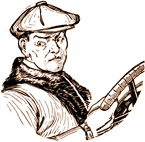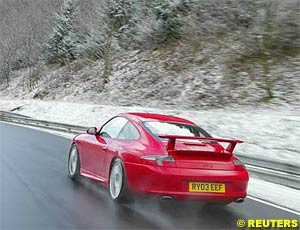

Automotive News and Reviews for the Petrolhead
Reuters Motoring Commentator
In this week's issue:
- Road Test: Lord of the Ring
- Volkswagen Upbeat on New Golf
I had always dreamed of driving a Porsche round the Nurburgring race circuit. Now my wish is about to come true.
Waiting at Guildford railway station for my co-driver to arrive, I wonder if I have left it too late. The Porsche 911 has moved on. It is a definite plus that the current 996-generation is no longer the choice of cocky young whiz-kids in red braces. But it is no longer the fearsome, tail-happy junior supercar that sets the adrenalin pumping the moment you turn the key. It is now wider, more comfortable and far more civilised. It even has rear seats usable by people with legs. Or so I imagine.
It was easy to see why she is intimidated. At first glance, the 375bhp GT3 is like any other 911. But open the door and you see the inside of a racing machine. The rear seats have been discarded to make way for a roll-cage and those in the front are single-piece bucket seats. And just in case you have forgotten your braces, the seat belts are bright red.
The impression of a road-legal racing car is reinforced as I slip inelegantly behind the wheel and start the engine. "What has happened to the soundproofing?" I muse. "Wait til you hear the road-noise," she says. "They have even left out the carpeting under the seats to save weight?"
The raw, uncompromising character of the GT3 becomes clear as we make our way to the Channel Tunnel. But it isn't until we reach Lille at midnight in search of a hotel that we fully appreciate the firmness of the suspension. Driving over cobbled streets is deafening and the all-enveloping Reccaro bucket seats verge on the painful. "Maybe we will enjoy it more in the daylight," I mumble hopefully?
Daylight breaks and we get on our way. The Nurburgring race circuit is set four hours away in the mountainous Eifel area between the Rhine and the Mosel rivers in western Germany. Overlooked by the ruins of a 12th century castle in the village of Nurburg, the roller coaster racetrack was built in the 1920s to reduce unemployment, promote tourism and provide a test facility for the German motor industry.
There were no less than 172 corners on each 19 mile lap. Back then, large run-off areas and gravel traps were unknown. Between the tarmac and the crash barriers gaps were minimal.
Lap of Peril
Many stars have won famous victories there since Rudi Caracciola won the inaugural race in 1927, but many lives were lost. "Nothing gave me more satisfaction than to win at the Nurburgring," said Jackie Stewart, "and yet, I was always afraid. When I left home for the German Grand Prix I always used to pause at the end of the driveway and take a long look back. I was never sure I'd come home again." Niki Lauda tried to organise a boycott of the race in 1976 on safety grounds. The event went ahead, but Lauda crashed and was badly burned, prompting the Nurburgring's F1 licence to be revoked. Nurburgring is now home to the European Grand Prix again, but the event is restricted to the 4.8 mile Southern section. For hardcore motoring enthusiasts, the neighbouring 14.2 mile Northern Loop is much more. It remains the longest - and probably the most difficult race circuit in the world.
The autoroutes and autobahns en route to 'the Ring' are perfect for coming to terms with our road-racer. Noisy and stiff, it may be, but the sheer power of the 3.6-litre V6 makes it a delight. Other motorists dive out of the way as they see the beast in their mirrors.
With 375bhp on tap, there is more than enough muscle to rival anything on the road. The GT3 sprints from 0-60mph in just 4.3 second and reaches 100mph in just over 10.
"I've changed my mind," I say. "This car is a real buzz." Moments later, the fear starts to return. Giant flakes of snow are drifting down. No need for wipers. The speed is blowing the flakes over the distinctive 911 bodyform. But the GT3 is shod with semi-slick tyres. "We're near the Ring now," I am told. "It has its own microclimate?"
We arrive minutes later. The Northern Loop is open for public use several hours most days of the year. Some of the cars on the circuit are advanced prototypes being tested by manufacturers. Many others are private road cars on British number plates, wearing discreet stickers showing maps of 'the ring' like badges of honour. But few are venturing on circuit. The temperature is freezing. The snow is settling.
Entry to the Ring is simple. An annual pass to use the Northern Ring costs 700 Euros, a single lap costs 14 and the charge for six laps is 76. You arrive, buy a ticket to open the barrier and you are away.
An American taps at the window. "If you are going on circuit, you had better know, there is snow across the track in several places. Careful?"
The first couple of laps are intimidating - particularly in the early April snowfall that added to the beauty of the 'Green Hell' woodlands but left the track damp and slippery. But the Porsche is supreme, revving to 8000rpm, powering to almost 160mph on the 1.5 mile straight and demonstrating its mighty brakes and enormous grip with nonchalant ease.
A Super Car
Noisy, raw and intoxicating, the GT3 is the epitome of the uncompromising supercar. The stiff front suspension gives a slight tendency to understeer, but the car snaps out of corners with almost animal-like ferocity. The engine is almost deafening: the six-speed gearchange sharp, precise and fast.
The lap-count mounts. The numerous corners become more familiar. The circuit remains as awesome as I had imagined, but the GT3 demonstrates its pedigree with ease. Practical? No. Sophisticated? No. Luxurious? Hardly!
Yet this is the stuff of dreams. The Porsche 911 may have matured and become less unpredictable in character, but it remains as awesome and desirable as ever.
Written by David Sumner Smith
Volkswagen has shrugged off a sharp fall in first quarter earnings, saying demand for its new Golf V model will help drive an improvement in operating profits in the coming months.
"For the second quarter, we expect a significant improvement in (operating) profits over the first quarter," Chief Financial Officer Hans Dieter Poetsch told an analysts' conference call last Friday.
Europe's largest carmaker also strengthened its commitment to earn more than 2.5 billion euros (1.7 billion pounds) before special items for the full year, as its flagship hatchback relaunched last October gains in popularity.
"The new Golf achieves a high market share already of 26.6 percent, leading this (compact) segment by far," Detlef Wittig, VW Brand management board member, told analysts. "The new Golf V has become a winner by now."
Shares in VW outperformed its European peers the entire session, as the market focused on the bullish outlook for both group earnings and sales of VW's most important model.
"VW already indicated that the first quarter would be weak," said Raed Mustafa, a dealer at BW Bank. "The main thing is that the demand for the Golf has jumped considerably."
"The fear that VW might have to revise its 2004 target of delivering about 600,000 Golf Vs is gone from the market for the time being," he added. Quarterly operating profit sank to 329 million euros from 604 million euros in the year-ago period, due almost entirely to its VW Brand Group and North American businesses, where earnings swung to a loss.
Euro Still Hurting Profits
Poetsch warned, however, that should the euro return to record highs, the full-year earnings target would be "very difficult" to reach. Any level above $1.25 would endanger VW's ability to reach its goals, he added.
Poetsch said assuming the dollar-euro level remained at the high levels it reached during the first quarter, during which currency effects cost VW 300 million euros, VW's group profits would be hit again.
Asked whether this could be extrapolated to the full year, he said: "Yes, it can be annualised." He said if the dollar continued at its current, higher level, the impact on profits could be "significantly lower".
The results come one day after VW agreed in principle to sell treasury shares totalling as much as 10 percent of the company's stock to the Gulf emirate of Abu Dhabi. Last Thursday, an Abu Dhabi delegation agreed to buy a stake in the carmaker, although VW Chief Executive Bernd Pischetsrieder said the size of the holding had not yet been agreed.
Analysts have applauded the decision, saying Pischetsrieder can now count on a powerful ally in his struggle to streamline VW's bloated cost base.
"It's a smart decision to bring a strong partner on board, and it should be positive for shareholders since Abu Dhabi is doubtless very interested in VW earning a reasonable return on equity," said Robert Pottmann, an analyst at M.M. Warburg, who rates VW a "hold".
In a separate deal, the Gulf emirate is joining up with Volkswagen and the Saudi-owned Olayan Group to acquire Europe's leading fleet management business LeasePlan for two billion euros.
Written by Christiaan Hetzner
![]() Road Test: Lord of the Ring
Road Test: Lord of the Ring
 When the bright red 911 GT3 finally arrives, I am in for a shock. My co-pilot looks terrified. "I can't drive this thing," she snaps. "I will just navigate."
When the bright red 911 GT3 finally arrives, I am in for a shock. My co-pilot looks terrified. "I can't drive this thing," she snaps. "I will just navigate."
 But strangely, it is not the raw power that impresses, but rather the flexibility. Sixth gear is good for anything from 35mph up to a theoretical maximum of 190mph. High speed travel is as fiery or as effortless as you could desire. Even my 'navigator' is persuaded to take the wheel and finds herself relaxing at 120mph.
But strangely, it is not the raw power that impresses, but rather the flexibility. Sixth gear is good for anything from 35mph up to a theoretical maximum of 190mph. High speed travel is as fiery or as effortless as you could desire. Even my 'navigator' is persuaded to take the wheel and finds herself relaxing at 120mph.
![]() Volkswagen Upbeat on New Golf
Volkswagen Upbeat on New Golf
| Contact the Editor |
© 2007 autosport.com . This service is provided under the Atlas F1 terms and conditions.
|
Volume 10, Issue 18
Articles
Every Other Sunday
The Paint Job VI
2004 Spanish GP Preview
2004 Spanish GP Preview
Spanish GP Facts & Stats
The F1 Trivia Quiz
Columns
Rear View Mirror
Bookworm Critique
On the Road
Elsewhere in Racing
The Weekly Grapevine
> Homepage |